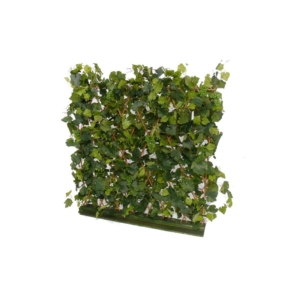
Planet-friendly artificial hedges and vertical gardens
Hedges and vertical gardens have something in common – they fence off, screen, decorate, and last but not least – they allow you to develop your space vertically. The former are found “outdoors” – on terraces, for example, and increasingly on balconies, while the latter have become a fashionable and modern decoration for interiors of various types. Vertical green walls can be created from natural plants, but increasingly popular are those made from artificial plants. An artificial green hedge or vertical garden has a lot of obvious advantages: it can be created anywhere, once established it does not need to be maintained or watered, its condition is not dependent on temperature or weather conditions. Surprisingly, however, such a screen or decoration can be very… EKO. To find out, it is worth examining the less obvious costs associated with natural and artificial plant decorations.

Carbon footprint: natural plants vs. artificial
Hedges and natural gardens seem to be more planet-friendly and environmentally friendly. After all, living plants produce oxygen and clean the air. Artificial ones can’t do that. There is no denying it, but there is also the other side of the coin, which is relatively rarely taken into account. And this is where the now frequently used term “carbon footprint” comes in.
A carbon footprint is nothing more than the total amount of greenhouse gas emissions caused by someone or something: an event, a person, an organization, or in this case, a product (when it is manufactured, installed, transported, used, etc.).
Establishing a living vertical garden, as we will focus on the example of a garden, involves obvious financial costs (the need to purchase plants, pots, substrate, fertilizers, installation, etc.), but also environmental costs, which are most easily approximated precisely using the concept of carbon footprint.
It can be estimated like this (actual values will vary, of course, depending on the size of the garden and other factors):
Living vertical garden – carbon footprint
- Stainless steel frame – 24 kg ofCO2 perm2;
- Transport of steel and packaging – 4 kgCO2;
- Plastic pots for the vertical garden – 20 kg ofCO2;
- Plastic irrigation pipes – 5.2 kg ofCO2;
- Soil for plants – 2.6 kg ofCO2 perm2 per year;
- Fertilizer – 0.35 kg ofCO2 perm2 per year;
- Crushed gravel (as needed) – 4.8 g ofCO2 per kg per year;
- Watering the vertical garden – about 1.5 kg ofCO2
Let’s discuss it briefly. A steel frame bounding a vertical garden usually consists of four metal profiles perm2 to attach pots. During the production of stainless steel, emissions are 6.15 kg ofCO2 per kg, so assuming we need one such frame, the carbon footprint will be about 24 kg ofCO2. The environmental costs of transporting steel (e.g., overseas, inland transportation, as well as packaging) should also be taken into account, which involves an average of approx. 4 kg ofCO2 additionally during the production process.
Once the steel frame is set, a lot of plastic is needed. It is necessary to purchase plastic pots in which the plants will be placed. For their production, with the assumed dimensions of the garden, it usually takes 6-8 kg of plastic, which means that the emissions will be about. 20 kg ofCO2 (6 or 8 × 2.7 kg).
To this point, the ecological costs for artificial and natural gardens are similar. But with live plants, you also need to consider plastic watering pipes. If we assume approx. 2 kg of plastic pipes, comes in addition to 5.2 kg ofCO2. Other issues include soil for plants (2.6 kg ofCO2 perm2 per year), fertilizers (approx. 350 g ofCO2 perm2 per year), possible insecticides and fungicides, gravel or other aggregate to aid drainage, water for watering – all of these further increase the carbon footprint. Well, and – it can’t be avoided – some of the living plants in vertical gardens need to be replaced every year, and those that are perennial, unfortunately, despite efforts and care, also sometimes die. Replenishing deficiencies or replacing plants increasesCO2 emissions, because the described costs of establishing a garden have to be mostly incurred again.
After subtracting the costs associated with transportation, it can be assumed that the carbon footprint for establishing a living vertical garden is an average of 55 kg ofCO2 perm2 per year.
And how is it with artificial plants?

Artificial vertical garden – carbon footprint
In this case, part of the cost (such as the steel frame, pots, etc., so the assembly, and before that the production and transportation of the elements) will be identical to the cost of establishing a garden from natural plants. But – which is insanely important! – An artificial garden is set up once and does not need to be maintained, fertilized, watered, soil or plants replaced, so a large part of the ecological costs can be eliminated.
At Wholesale Artificial Plants, we go to great lengths to ensure that our products are earth-friendly. Our vertical gardens made of artificial plants have an average carbon dioxide emission of 5.2 kg perm2!

Organic artificial plants – good for humans and the planet
At Wholesale Artificial Plants, we take a responsible and ethical approach to our work, offering products that are tested and Earth-friendly. We know what our customers care about because, like them, when we buy cars, toys, food, we expect high quality and safety. This is what we want to provide. We do not accept half-measures. There are no toxic chemicals in our plants, which are not difficult to find in cheap substitutes available on the market. Our products are made in accordance with the requirements enshrined in the RoHS ( Restriction of Hazardous Substances) Directive. That is, they don’t have it in them:
- lead;
- mercury;
- boric acid;
- Heavy metals in plastic;
- cadmium;
- chromium;
- polybromodiphenyl compounds;
- polybrominated diphenylethers.
When you decide to set up a vertical garden with artificial plants with us, buy our artificial hedge or any artificial decoration from our range, you can be sure that you are buying a good product – one that does no harm, is durable, safe and planet-friendly.
